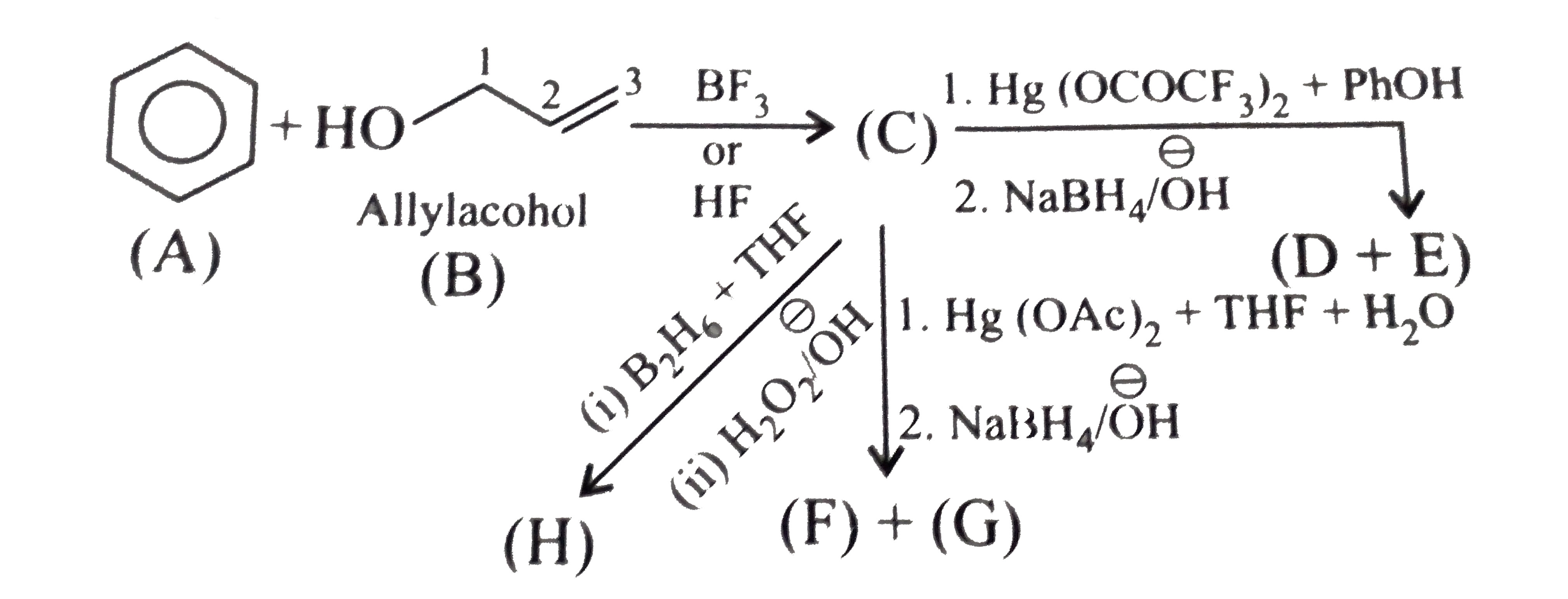Oxidation reaction involves loss of electrons, and reduction reaction involves gain of electrons. The reaction in which a species disproportinates into two oxidation states ( lower and higher) is called disproportionation reaction.
Which of the following statements is wrong?
Acidified KMnO4 solutions decolourises on the addition of sodium oxalate.
In the reaction between Br2 and CsI,Br2 is an oxidising agent and CsI is a reducing agent.
In the reaction 2K2SO3+I2→2KI+K2S4O6, the change in the oxidation number of S is 0.5.
C has the same oxidation number in both CH4 and CO2
The correct Answer is:D
To determine which of the statements is wrong regarding oxidation and reduction reactions, we will analyze each statement step by step.
Step 1: Analyze the first statement
Statement 1: Acidified KMnO4 solution decolorizes on addition of sodium oxalate.
- Reaction:
KMnO4+C2O2−4→Mn2++CO2
- Oxidation states:
- In KMnO4, Mn has an oxidation state of +7.
- In Mn²⁺, Mn has an oxidation state of +2.
- Conclusion: The purple color of KMnO4 disappears as Mn is reduced from +7 to +2. Thus, this statement is correct.
Step 2: Analyze the second statement
Statement 2: In the reaction between bromine and cesium iodide, Br2 is an oxidizing agent and cesium iodide is a reducing agent.
- Reaction:
Br2+CsI→CsBr+I2
- Oxidation states:
- Br2 has an oxidation state of 0 and is reduced to Br⁻ (oxidation state -1).
- I⁻ is oxidized to I2 (oxidation state 0).
- Conclusion: Br2 is indeed the oxidizing agent and CsI (iodide) is the reducing agent. Thus, this statement is correct.
Step 3: Analyze the third statement
Statement 3: In the reaction 2K2S2O3+I2→2KI+K2S4O6, the change of oxidation number of sulfur is 0.5.
- Oxidation states:
- In S2O2−3, let the oxidation state of sulfur be x:
2x+3(−2)=−2⟹2x−6=−2⟹2x=4⟹x=+2
- In S4O2−6:
4x+6(−2)=−2⟹4x−12=−2⟹4x=10⟹x=2.5
- Change in oxidation state:
2.5−2=0.5
- Conclusion: The change in oxidation state of sulfur is indeed 0.5. Thus, this statement is correct.
Step 4: Analyze the fourth statement
Statement 4: Carbon has the same oxidation number in both CH4 and CO2.
- Oxidation states:
- In CH4:
x+4(+1)=0⟹x=−4
- In CO2:
x+2(−2)=0⟹x=+4
- Conclusion: The oxidation state of carbon in CH4 is -4 and in CO2 is +4, which are not the same. Thus, this statement is wrong.
Final Answer
The wrong statement is Statement 4: Carbon has the same oxidation number in both CH4 and CO2.
---
Statement 1: Acidified KMnO4 solution decolorizes on addition of sodium oxalate.
KMnO4+C2O2−4→Mn2++CO2
- Oxidation states:
- In KMnO4, Mn has an oxidation state of +7.
- In Mn²⁺, Mn has an oxidation state of +2.
- Conclusion: The purple color of KMnO4 disappears as Mn is reduced from +7 to +2. Thus, this statement is correct.
Statement 2: In the reaction between bromine and cesium iodide, Br2 is an oxidizing agent and cesium iodide is a reducing agent.
Br2+CsI→CsBr+I2
- Oxidation states:
- Br2 has an oxidation state of 0 and is reduced to Br⁻ (oxidation state -1).
- I⁻ is oxidized to I2 (oxidation state 0).
- Conclusion: Br2 is indeed the oxidizing agent and CsI (iodide) is the reducing agent. Thus, this statement is correct.
Statement 3: In the reaction 2K2S2O3+I2→2KI+K2S4O6, the change of oxidation number of sulfur is 0.5.
- In S2O2−3, let the oxidation state of sulfur be x:
2x+3(−2)=−2⟹2x−6=−2⟹2x=4⟹x=+2
- In S4O2−6:
4x+6(−2)=−2⟹4x−12=−2⟹4x=10⟹x=2.5
- Change in oxidation state:
2.5−2=0.5
- Conclusion: The change in oxidation state of sulfur is indeed 0.5. Thus, this statement is correct.
Statement 4: Carbon has the same oxidation number in both CH4 and CO2.
- In CH4:
x+4(+1)=0⟹x=−4
- In CO2:
x+2(−2)=0⟹x=+4
- Conclusion: The oxidation state of carbon in CH4 is -4 and in CO2 is +4, which are not the same. Thus, this statement is wrong.
The wrong statement is Statement 4: Carbon has the same oxidation number in both CH4 and CO2.
Topper's Solved these Questions
- REDOX REACTIONSBOOK - CENGAGE CHEMISTRY ENGLISHCHAPTER - REDOX REACTIONSEXERCISE - Exercises (Multiple Correct)
32 Videos
- REDOX REACTIONSBOOK - CENGAGE CHEMISTRY ENGLISHCHAPTER - REDOX REACTIONSEXERCISE - Exercises (Single Correct)
91 Videos
- REDOX REACTIONSBOOK - CENGAGE CHEMISTRY ENGLISHCHAPTER - REDOX REACTIONSEXERCISE - Exercise
29 Videos
- PURIFICATION OF ORGANIC COMPOUNDS AND QUALITATIVE AND QUANTITATIVE ANALYSISBOOK - CENGAGE CHEMISTRY ENGLISHCHAPTER - PURIFICATION OF ORGANIC COMPOUNDS AND QUALITATIVE AND QUANTITATIVE ANALYSISEXERCISE - Assertion Reasoning Type
5 Videos
- S-BLOCK GROUP 1 - ALKALI METALSBOOK - CENGAGE CHEMISTRY ENGLISHCHAPTER - S-BLOCK GROUP 1 - ALKALI METALSEXERCISE - Archives Subjective
8 Videos
Similar Questions
Oxidation reaction involves loss of electrons, and reduction reaction involves gain of electrons. The reaction in which a species disproportinates into two oxidation states ( lower and higher) is called disproportionation reaction.
Which of the following statements is correct?
View SolutionOxidation reaction involves loss of electrons, and reduction reaction involves gain of electrons. The reaction in which a species disproportinates into two oxidation states ( lower and higher) is called disproportionation reaction.
Which of the following is not a dispropotional reaction?
View Solution
Knowledge Check
Which of the following is a disproportionation reaction?
ACl2(g)+2OH−(aq)→ClO−(aq)+Cl−(aq)+H2O(l)BCl2(g)+2I−(aq)→2Cl−(aq)+I2(s)C2Fe(s)+3H2O(l)Δ−−→Fe2O3(s)+3H2(g)D2H2O(l)+2F2(g)→4HF(aq)+O2(g)Which of the following is not a disproportionation reaction ?
AP4(s)+3OH−(aq)+3H2O(l)→PH3(g)+3H2PO−2(aq)B2F2(g)+2OH−(aq)→2F−(aq)+OF2(g)+H2O(l)CCl2(g)+2OH−(aq)→ClO−(aq)+Cl−(aq)+H2O(l)D2H2O2(aq)→2H2O(l)+O2(g)
Test cross involves
View Solution
The reaction (C ) to (F and G) is called mercuration-demercuration reaction. Which of the following statements is wrong about the reaction.
View SolutionWhich of the following is/ are disproportionation reactions?
View SolutionThe reduction half reaction represents the gain of electrons.
View SolutionWhich of the following is/are disproportionation reactions ?
View SolutionWhich of the following is not a disproportionation reaction ?
View Solution
